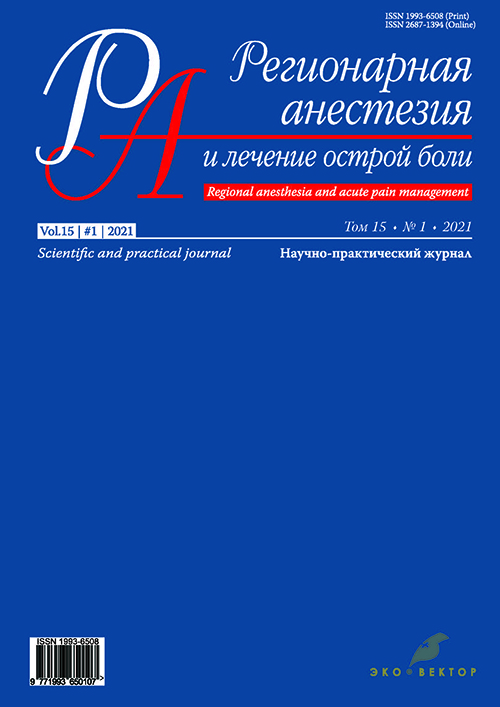Pterygopalatine fossa block and dexmedetomidine as components of stress-limiting anesthesia in ophthalmic surgery
- 作者: Mynka N.V.1,2, Kobelyatskyy Y.Y.1
-
隶属关系:
- Dnipropetrovsk medical academy
- Dnepropetrovsk Regional Clinical Ophthalmologic Hospital
- 期: 卷 15, 编号 1 (2021)
- 页面: 33-40
- 栏目: Original articles
- URL: https://bakhtiniada.ru/1993-6508/article/view/75936
- DOI: https://doi.org/10.17816/1993-6508-2021-15-1-33-40
- ID: 75936
如何引用文章
详细
BACKGROUND: To date, surgical interventions continue to be accompanied by a high proportion of complications and even death. In half of the cases, mortality and serious postoperative complications could have been prevented. After a comprehensive study of the factors affecting the prolongation of hospitalization and rehabilitation (Kehlet H., 1997; Kehlet H., Wilmore D., 2002), surgical stress response was identified as the most significant inducer of dysfunction among various organs and systems. General anesthesia, in its classical sense, is not able to provide patients with complete protection against surgical trauma. Comprehensive protection can be obtained through a combination of general and local anesthesia and stress-protective drugs.
OBJECTIVE: The aim of this study was to evaluate the efficacy and safety of the proposed scheme of stress-limiting anesthesia in ophthalmic surgery patients with corneal transplantation.
MATERIALS AND METHODS: This study provides a comparative characterization of the severity of the stress response and pain syndrome in patients operated under the conditions of “classical” general anesthesia (group K) and those who received the scheme of stress-limiting anesthesia (group DB). Multicomponent anesthesia was administered in both groups. Sibazone was used for sedation in group K, whereas dexmedetomidine was used in group DB. The patients in group DB underwent local anesthesia before surgery. The main criteria for assessing the results were as follows: hemodynamic stability, blood glucose, level of venous blood leukocytes, and severity of pain according to the VAS in the postoperative period.
RESULTS: Both schemes helped avoid pronounced fluctuations in hemodynamic and gas exchange parameters at all stages of the study. The analysis of blood glucose and leukocyte counts showed that patients in group K had a more significant deviation for both indicators from the preoperative level than those in group DB. In the study of pain syndrome, group K showed higher levels of pain according to the VAS than group DB.
CONCLUSION: The scheme of stress-limiting anesthesia enables the control of postoperative pain without the additional use of narcotic analgesics and blockades in the postoperative period.
作者简介
Nadezhda Mynka
Dnipropetrovsk medical academy; Dnepropetrovsk Regional Clinical Ophthalmologic Hospital
编辑信件的主要联系方式.
Email: nice.barannik@ukr.net
ORCID iD: 0000-0001-5024-911X
post-graduate student
乌克兰, 9, V. Vernadsky st., Dnipro, 49044; DniproYuriy Kobelyatskyy
Dnipropetrovsk medical academy
Email: kobeliatsky@ukr.net
ORCID iD: 0000-0002-8504-6125
MD, PhD, Professor
乌克兰, 9, V. Vernadsky st., Dnipro, 49044参考
- Kobelyatskii YY. New approaches to the regulation of the operational stress response. Zdorov’e Ukrainy. 2017;(2):2–6. (In Russ).
- Ovechkin AM. Surgical stress-response, its pathophysiological significance and methods of modulation. Regionarnaya anesteziya i lechenie ostroy boli. 2008;2(2):49–62. (In Russ).
- Kehlet H. Postoperative pain relief–what is the issue? Br J Anaesth. 1994;72(4):375–378. doi: 10.1093/bja/72.4.375
- Desborough JP. The stress response to trauma and surgery. Br J Anaesth. 2000;85(1):109–117. doi: 10.1093/bja/85.1.109
- Kehlet H. The modifying effect of anesthetic technique on the metabolic and endocrine responses to anesthesia and surgery. Acta Anaesthesiol Belg. 1988;39(3):143–146.
- Meiler SE. Long-term outcome after anesthesia and surgery: remarks on the biology of a newly emerging principle in perioperative care. Anesthesiol Clin. 2006;24(2):255–278. doi: 10.1016/j.atc.2006.03.002
- Kehlet H, Holte K. Effect of postoperative analgesia on surgical outcome. Br J Anaesth. 2001;87(1):62–72. doi: 10.1093/bja/87.1.62
- Besedovsky HO, del Rey A. Immune-neuro-endocrine interactions: facts and hypotheses. Endocr Rev. 1996;17(1):64–102. doi: 10.1210/edrv-17-1-64
- Beilin B, Shavit Y, Trabekin E, et al. The effects of postoperative pain management on immune response to surgery. Anesth Analg. 2003;97(3):822–827. doi: 10.1213/01.ane.0000078586.82810.3b
- Kasachenko VM, Briskin BS, Evstifeeva OV, Savchenko ZI. The impact of the type of anesthesia on stress-realizing and stress-limiting mechanisms of the immune system in gerontological patients at abdominal surgeries. Eksp Klin Gastroenterol. 2004(3):58–61, 105.
- Adams HA, Hempelmann G. The endocrine stress reaction in anesthesia and surgery--origin and significance. Anasthesiol Intensivmed Notfallmed Schmerzther. 1991;26(6):294–305. doi: 10.1055/s-2007-1000588 (In German)
- Antomonov MY. Mathematical processing and analysis of biomedical data. Kiev: Medinform; 2018. (In Russ).
补充文件










